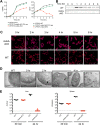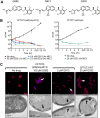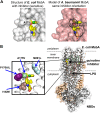Disrupting Gram-Negative Bacterial Outer Membrane Biosynthesis through Inhibition of the Lipopolysaccharide Transporter MsbA
- PMID: 30104274
- PMCID: PMC6201111
- DOI: 10.1128/AAC.01142-18
Disrupting Gram-Negative Bacterial Outer Membrane Biosynthesis through Inhibition of the Lipopolysaccharide Transporter MsbA
Abstract
There is a critical need for new antibacterial strategies to counter the growing problem of antibiotic resistance. In Gram-negative bacteria, the outer membrane (OM) provides a protective barrier against antibiotics and other environmental insults. The outer leaflet of the outer membrane is primarily composed of lipopolysaccharide (LPS). Outer membrane biogenesis presents many potentially compelling drug targets as this pathway is absent in higher eukaryotes. Most proteins involved in LPS biosynthesis and transport are essential; however, few compounds have been identified that inhibit these proteins. The inner membrane ABC transporter MsbA carries out the first essential step in the trafficking of LPS to the outer membrane. We conducted a biochemical screen for inhibitors of MsbA and identified a series of quinoline compounds that kill Escherichia coli through inhibition of its ATPase and transport activity, with no loss of activity against clinical multidrug-resistant strains. Identification of these selective inhibitors indicates that MsbA is a viable target for new antibiotics, and the compounds we identified serve as useful tools to further probe the LPS transport pathway in Gram-negative bacteria.
Keywords: ABC transporters; Enterobacteriaceae; Escherichia coli; MsbA; lipopolysaccharide; outer membrane.
Copyright © 2018 American Society for Microbiology.
Figures




Similar articles
-
Combining Mutations That Inhibit Two Distinct Steps of the ATP Hydrolysis Cycle Restores Wild-Type Function in the Lipopolysaccharide Transporter and Shows that ATP Binding Triggers Transport.mBio. 2019 Aug 20;10(4):e01931-19. doi: 10.1128/mBio.01931-19. mBio. 2019. PMID: 31431556 Free PMC article.
-
The Lpt ABC transporter for lipopolysaccharide export to the cell surface.Res Microbiol. 2019 Nov-Dec;170(8):366-373. doi: 10.1016/j.resmic.2019.07.005. Epub 2019 Aug 1. Res Microbiol. 2019. PMID: 31376484
-
Functional Interaction between the Cytoplasmic ABC Protein LptB and the Inner Membrane LptC Protein, Components of the Lipopolysaccharide Transport Machinery in Escherichia coli.J Bacteriol. 2016 Jul 28;198(16):2192-203. doi: 10.1128/JB.00329-16. Print 2016 Aug 15. J Bacteriol. 2016. PMID: 27246575 Free PMC article.
-
The lipopolysaccharide transport (Lpt) machinery: A nonconventional transporter for lipopolysaccharide assembly at the outer membrane of Gram-negative bacteria.J Biol Chem. 2017 Nov 3;292(44):17981-17990. doi: 10.1074/jbc.R117.802512. Epub 2017 Sep 6. J Biol Chem. 2017. PMID: 28878019 Free PMC article. Review.
-
Structural insight into lipopolysaccharide transport from the Gram-negative bacterial inner membrane to the outer membrane.Biochim Biophys Acta Mol Cell Biol Lipids. 2017 Nov;1862(11):1461-1467. doi: 10.1016/j.bbalip.2017.08.003. Epub 2017 Aug 15. Biochim Biophys Acta Mol Cell Biol Lipids. 2017. PMID: 28821406 Review.
Cited by
-
Chemical genetic approaches for the discovery of bacterial cell wall inhibitors.RSC Med Chem. 2023 Aug 30;14(11):2125-2154. doi: 10.1039/d3md00143a. eCollection 2023 Nov 15. RSC Med Chem. 2023. PMID: 37974958 Free PMC article. Review.
-
Fosfomycin Resistance Evolutionary Pathways of Stenotrophomonas maltophilia in Different Growing Conditions.Int J Mol Sci. 2022 Jan 20;23(3):1132. doi: 10.3390/ijms23031132. Int J Mol Sci. 2022. PMID: 35163052 Free PMC article.
-
Gradients in gene essentiality reshape antibacterial research.FEMS Microbiol Rev. 2022 May 6;46(3):fuac005. doi: 10.1093/femsre/fuac005. FEMS Microbiol Rev. 2022. PMID: 35104846 Free PMC article. Review.
-
Folded Synthetic Peptides and Other Molecules Targeting Outer Membrane Protein Complexes in Gram-Negative Bacteria.Front Chem. 2019 Feb 6;7:45. doi: 10.3389/fchem.2019.00045. eCollection 2019. Front Chem. 2019. PMID: 30788339 Free PMC article. Review.
-
Nanodrug Delivery Systems for Direct Clearance or Neutralization of LPS.Int J Nanomedicine. 2025 Jul 3;20:8653-8673. doi: 10.2147/IJN.S510037. eCollection 2025. Int J Nanomedicine. 2025. PMID: 40626135 Free PMC article. Review.
References
-
- World Health Organization. 2014. Antimicrobial resistance: global report on surveillance. World Health Organization, Geneva, Switzerland: http://www.who.int/drugresistance/documents/surveillancereport/en/.
-
- Centers for Disease Control and Prevention. 2013. Antibiotic resistance threats in the United States, 2013. Centers for Disease Control and Prevention, Atlanta, GA: https://www.cdc.gov/drugresistance/threat-report-2013/pdf/ar-threats-201....
-
- Osborn MJ, Gander JE, Parisi E. 1972. Mechanism of assembly of the outer membrane of Salmonella typhimurium. Site of synthesis of lipopolysaccharide. J Biol Chem 247:3973–3986. - PubMed
-
- Osborn MJ, Gander JE, Parisi E, Carson J. 1972. Mechanism of assembly of the outer membrane of Salmonella typhimurium. Isolation and characterization of cytoplasmic and outer membrane. J Biol Chem 247:3962–3972. - PubMed
Publication types
MeSH terms
Substances
LinkOut - more resources
Full Text Sources
Other Literature Sources
Molecular Biology Databases

